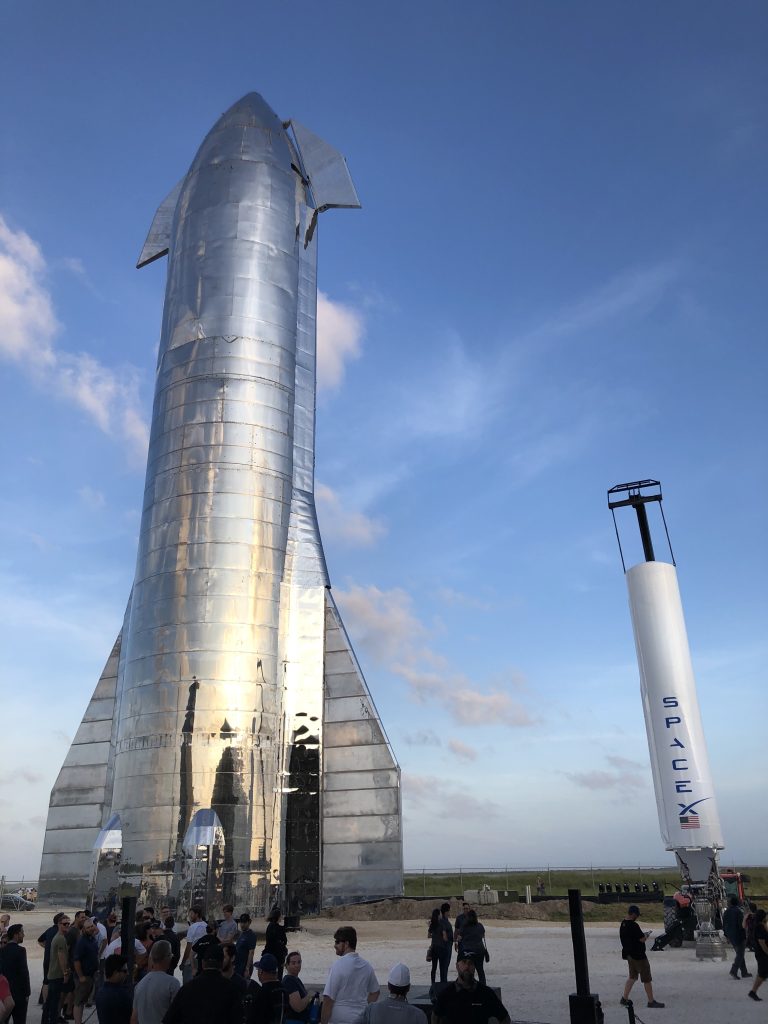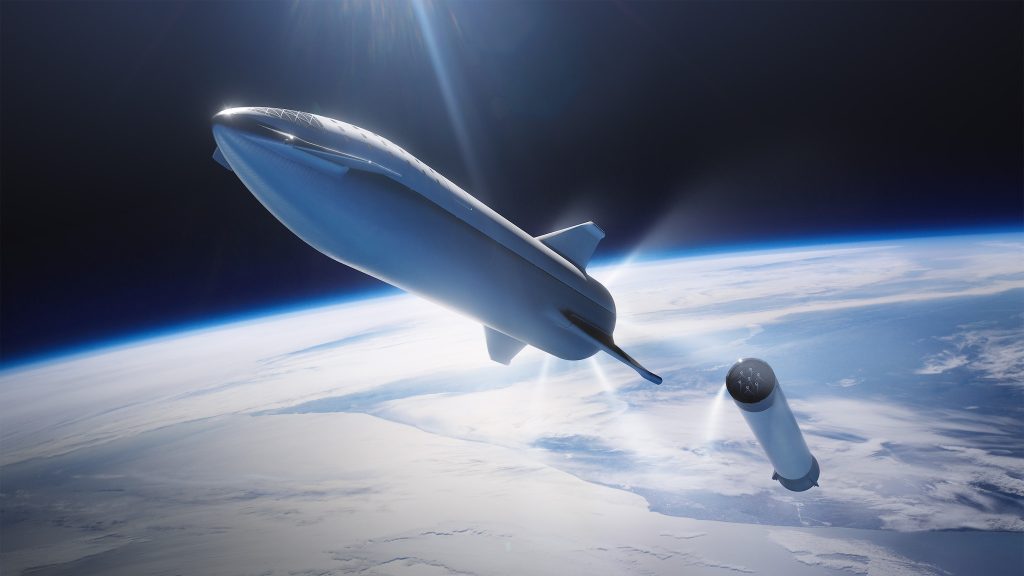The development of a highway to Mars
Authors: Marcos Talocchi and Lisanne Vermaas, Editors Leonardo Times
The future of spaceflight is, in short, defined by one word: sustainability. And what other way to achieve it other than leaving single use launchers in the past and embrace reusable rockets? This is what SpaceX proposes with Starship, the first 100% reusable space launcher.
Space Exploration Technologies Corporation, or SpaceX in short, was founded by Elon Musk in 2002. His plans to colonize Mars in order to make mankind a multiplanetary species stems from even before SpaceX was founded. After generating his initial capital as co-founder of PayPal, Musk joined the board of the Mars Society and announced Mars Oasis: A project dedicated to the foundation of a greenhouse on Mars in an attempt to revive public interest in space [1]. When it turned out to be financially impossible to send a rocket to space for this purpose, Musk decided to build his own. After three failed launch attempts, SpaceX managed to put their first rocket, the Falcon 1, in Low Earth Orbit (LEO) in 2008 [2]. Meanwhile, SpaceX had shifted focus towards reusability of rockets to cut launch prices. Already in 2005, they announced Falcon 9, a partially reusable twostaged rocket. In 2012, they started their reusability test program with low-altitude and low-speed landing technology, followed by more high-altitude and velocity tests in 2013 [3]. On the 22th of December 2015, Falcon 9 was the first orbital-class rocket to land its first stage on land after separation. As SpaceX wanted to extend the reusability even further, they announced their plans for a fully reusable rocket system as a part of the Mars Colonization Transport (MCT) in 2012 [4].
STARSHIP’S FIRST ANNOUNCEMENT
The Mars Colonial Transporter rocket, first announced in 2012 by Elon Musk as an “evolution of SpaceX’s Falcon 9 booster” [16], would be able to carry 100 tons of payload and would be powered by Raptor engines, developed and produced by SpaceX internally. On the 26th of September 2016, the Raptor engine fired for the first time [5]. The day after, at the International Astronautical Congress, Musk introduced the fully reusable Interplanetary Transport System launch vehicle. This project, which was a continuation of the MCT, would not only target Mars, but would go even beyond the Red planet. The rocket could carry three types of payload: crew, cargo and propellant. The latter one would be used for in orbit refueling [6]. The Low-Earth Orbit launch capacity was increased to 300 tons. In 2017, Musk revealed details of the revised project, which was renamed to BFR (Big Falcon Rocket). The LEO launch capacity was decreased to 150 tons but there were now more applications for the rocket [7]. The rocket could supply the ISS, launch satellites, land on the Moon and ship crew to Mars. In September 2018, after the addition of flaps to the design for control purposes, the booster was named Super-Heavy and the spacecraft received the name Starship.
FUNCTION OF THE SPACECRAFT
Starship will be used to carry cargo and astronauts to LEO, the ISS, the Moon, Mars and even beyond [8]. As Sartship is fully reusable, it will cut launch cost significantly and will be available for three launches a day [9]. In 2023, Starship will house the first space tourists on a lunar fly-by mission called DearMoon. The crew will consist of Yusaku Maezawa, who organizes the trip together with SpaceX, and 8 artists. They will spend a week beyond the Karman line with the goal of getting inspired by the space environment. Starship will also perform the task of launching SpaceXs second generation of nearly 30 000 Starlink satellites in LEO, and, at their end of life, recover them to reduce the amount of space debris [10][11]. SpaceX envisions Starship to enable point-to-point travel of Earth in the future, reducing travel time to 1 hour everywhere on Earth [12]. The Mars variant of Starship will be able to land on the Red planet and return to Earth [13]. In order to achieve this, Starship will be refueled in space [14]. After landing on Mars, Starship will create its own propellants by forming liquid oxygen and liquid methane from Martian water and carbon dioxide in a power-to-gas plant [15].

GENERAL DEVELOPMENT
Since beginning its development in 2012 under the name of Mars Colonial Transporter, Starship has undergone many changes over the years. For example, in 2018 the configuration of a delta wing at the rear end of the second stage was changed for two canard fins and three rear fins; and in 2019 the material of the body was changed from carbon fiber to stainless steel. The reasoning behind this was that due to its high melting point and strengthening in cryogenic temperatures, the structure of the rocket could be made much thinner than initially thought, also foregoing the use of ceramic shielding in some parts of the body when reentering the atmosphere.
The general development of the launcher has followed the SpaceX design philosophy of constant iterations and prototyping (as opposed to years of research before any tests take place). A vast amount of prototypes for the second stage have been built over the years, constantly adding up on each other and expanding upon its predecessors. They have been expanding from structural tests and static fires, to high altitude test fights and finally should be able to eventually perform orbital launches.
The construction site for all of the prototypes, and also where most of the research, launches and testing take place, is located in Boca Chica, Texas. Since 2018 it has been repurposed by SpaceX to focus exclusively on the development of Starship. There are also plans to expand the site as the development of the launcher progresses.
LATESTS NEWS
Recently, more and more Starship tests have been taking place, the most recent one (as of the writing of this article on December 1st 2022) having taken place on November 29 [17]. It consisted of a long-duration static firing of 11 out of the 33 Raptor 2 engines from Booster 7, one of their latest prototypes. This is the same model who had previously, on November 14, fired 14 of the engines.
Elon Musk has also announced on Twitter on November 15 that the Starship was a couple of static fires away from performing an orbital launch. This is a crucial step and milestone in the development of the launcher, meaning it might become operational in just a few years time.
On the second stage side, Ship 24 is the latest test prototype that has been developed. On September 24 all six of its engines were successfully fired [18]. This is likely to make the launcher’s first ever orbital flight together with Booster 7.
CONCLUSION
As Starship’s development approaches its final stages, space enthusiasts grow more and more enthusiastic about the launcher’s maiden flight. The possibilities enabled by the decrease of cost to launch payload, both to Earth orbit and the Solar System, are countless and the technological advancements in the Space field are certain. Reusable rockets are the next step in humankind’s space exploration age, and Starship is the next step of this new era.

